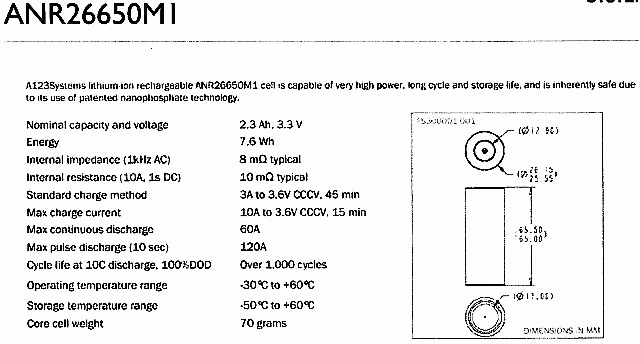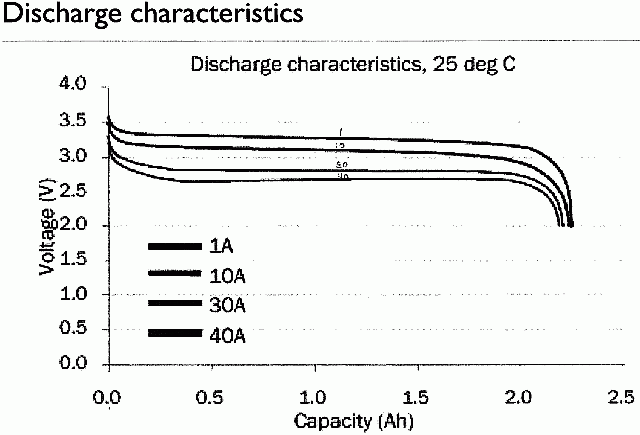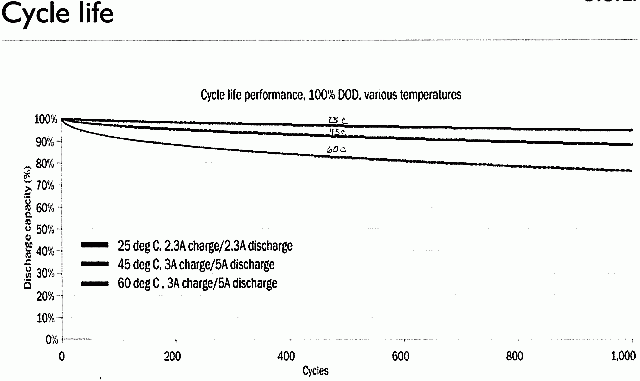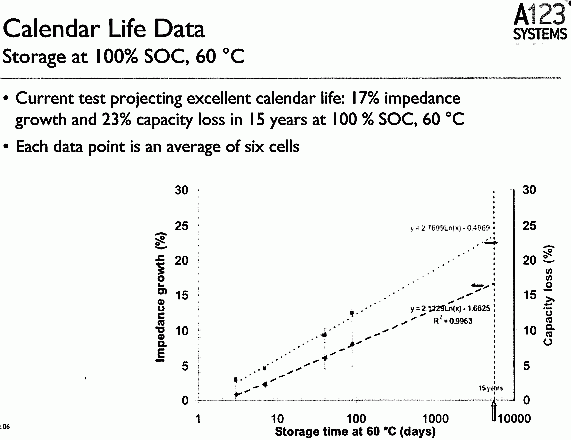A few weeks ago my ancient (in battery years) Trojan T-105 house batteries finally gave up the ghost at the ripe old age of eight years. I started the process of trying to find replacements, which is not an easy process on this small island in the South Pacific. I found only one 6V golf cart battery on island and it had been unattended on the shelf for five years (it had a shipping date on it). So, I started shopping on-line and of course found many sources. I was rather dismayed to find that the price had doubled since the last purchase. Okay, that's how most things are these days. Then I started on the shipping issue and was astounded by the difficulties involved this time around. Bottom line is that the cost to get just two T-105s, delivered here, would be about $500. This started me questioning the advisability of continuing on with lead acid batteries for the RE system.
I have another hobby where batteries get a lot of use - radio controlled model aircraft (RC). A few years ago I started converting all of my planes, which had previously been powered by internal combustion engines, to electric power. This is now feasible because of the development of much better batteries, motors and controllers. It occurred to me that some of the battery parameters important to this hobby parallel those of an RE system, although size and weight aren't very significant for RE. However, deep discharge, high charge and discharge rates, charge efficiency and lifetime are.
The past ten years or so has seen some rather remarkable advances in battery technology, most of which involve the element lithium. Various lithium chemistries have evolved to compete with the time honored lead acid and nickel based types. A major impetus for this development is probably the potential electric vehicle market, although portable electronic devices (cell phones, laptops music players etc.) are right up there.
About two years ago, one of the lithium ion types caught my eye and the more I learned, the better I liked them. The chemistry is Lithium Iron Phosphate (LiFePO4). One company, A123 Systems, claimed improved performance and safety with their "nanophosphate" technology and indeed, the specs looked great.

I've been using these cells in my planes for some time now and am quite pleased with the result as are numerous others as noted on the RC forums. One important difference between these and the more popular lithium polymer (LiPo) type is the safety factor. LiPos have a nasty reputation of bursting into flames if abused either by accident or neglecting the charge/discharge rules. I certainly don't want to burn down my house because of a battery. The A123 LiFe cells don't have these issues.
The main commercial application for the A123 LiFe cells seems to be in Dewalt tool power packs in 36V, 28V or 18V versions. A lot of RC'ers have bought these packs (frequently on eBay) and stripped out the 10 cells (36V pack) to reassemble into suitable packs for their planes, cars and boats. Using the Dewalt packs, the cost often works out to $10-12 per cell - pretty pricey but take a look at the data:



If we analyze this performance in comparison to the typical RE flooded lead acid battery, we find that it's really no contest, but there's still the cost factor to consider since it would take a bunch of cells to make a pack suitable for RE.
For comparison purposes, let's assume a simple RE lead acid battery using two Trojan T-105 6V 225Ah golf-cart batteries in series for a 12V nominal system. Now, my rule of thumb to realize a good lifetime is to limit cycle depth of discharge (DOD) to 25% of "actual" capacity on average. Notice I say actual capacity instead of rated capacity. My experience with T-105's shows an average of about 10% capacity loss per year of daily cycle service when observing the 25% rule. In reality, this means that my 225Ah rated battery is only 56 Ah initially and decreases continuously. At the end of five years, it's only 28 Ah.
The 25 deg C Cycle Life graph for the LiFe cells shows 95% remaining capacity after about three years of daily cycles at 100% DOD. However, note that this is with a 1C (C = rated capacity) discharge rate, which is much greater than we would typically see in an RE system. Almost certainly we would see a much greater cycle life at say a 0.1C discharge rate. I would fully expect to see several thousand cycles in RE usage, particularly if the DOD was a little more conservative at say, 90-95%. If you tried this with lead acid, they'd be gone in a year or less.
It's apparent that we could expect a much greater lifetime using LiFe cells in RE although they haven't been around long enough to have real examples. This will directly reduce our cost per year and mitigates the higher initial cost.
Lifetime isn't the only advantage. Look at the discharge curves and notice how flat they are with a sudden drop off right near the end of capacity. This is a more desirable characteristic than what lead acid delivers. The loads will see a near constant voltage to retain their performance. Ever see a fan continue to slow down or lights go dimmer as the lead acid battery discharges?
How about those rated discharge rates? 60A continuous, which is about 30C, from a single cell about the same size as a "D" flashlight battery, is pretty impressive. Don't try a 30C discharge with a lead acid! Of course, we would have many cells in parallel/series to make a useful pack for RE. This implies a pack discharge capability of well over 1000A (if the interconnects could take it). By the way, I've started my car with eight cells. So, they can handle very high peak loads without damage.
Charge rates for lead acid should usually be limited to about 0.1C to prevent excessive out-gassing and/or temperature rise. This limits a small battery bank being charged from a relatively high power source, even an intermittent one such as a wind turbine in high winds. These LiFe cells can be charged at 5C (50 times greater), without risk, to take advantage of more of the available energy. Some of the RC'ers do even more than that for charge times of 6-7 minutes.
Although not specified by A123 Systems, I measured charge effeciency at better than 95%. We could only wish for this in lead acid. This means better utilization of available energy and, of course, no out-gassing and little generated heat.
To test these cells in a RE environment, I took four of my 4-cell packs and connected them in parallel to give a rated capacity of 9.2 Ah. With a nominal cell voltage of 3.3V, a 4-cell series pack has a nominal voltage of 13.2V, which is fine for a 12V RE system. They are charged to a maximum voltage of 14.4V (3.6V/cell), which also fits okay. Other lithium chemistries have a nominal cell voltage of 3.6-3.7V and charge to 4.2V per cell, which doesn't work out too well for conventional RE systems. In RC, we designate our packs with a series-parallel label such as 4S1P. When four of these series packs are paralleled it effectively becomes a 4S4P pack for a total of 16 cells.
I installed this pack in my solar system along with a Xantrex C-40 controller. The bulk voltage was set at 14.4V and the float at 14.0V, which are somewhat different than the lead acid settings. The 3-stage charging of the C-40 is essentially of the "constant-current constant-voltage" (CCCV) type, which is what LiFe likes. Yes, it's not really constant-current but the array output is less than the max allowable charge current of the battery, so all is okay. The loads are ceiling fans, 40W fluorescent lights, CFL lights and LED night lights (60).
One disadvantage of the Lithium ion batteries is their requirement for strictly controlled voltage limits during both charge and discharge. The LiFe type seems a bit more tolerant to minor abuse of these limits. Some of the other lithium types can be ruined easily if the limits, either high or low, are exceeded. To protect the low voltage limit I connected another C-40 for low voltage load disconnect. Also, the voltage balance between cells in a series string is critical. This implies that a "Battery Management System" (BMS) electronic module is needed for unattended operation. A number of these have been developed for the electric bike and scooter market.
I've run the system for a month with no issues other than the small capacity. The results were so encouraging that I went ahead and bought 100 cells from eBay. These are from a Hong Kong supplier who removes them from new Dewalt packs just as I did for my RC packs. The cost works out to $4.25 per cell. The shipping by mail isn't cheap at $120 so the total cost per cell is $5.45 delivered here. Interestingly enough, the $545 total isn't much different than that for the T-105s.
I will use 96 of these cells to make a 4S24P pack of 55.2 Ah capacity, which is about equivalent to two T-105s at 25% capacity. They will be interconnected in a parallel-series configuration rather than series-parallel to allow for cell balancing. The estimated weight of the assembled pack will be about 16 lb compared to the T-105s at 125 lb. The pack size works out to be 3" x 12" x 8", obviously much smaller than the lead acid. Since there is no out-gassing, there are no issues to having them inside. I am also looking forward to zero maintenance - no checking and adding water, no messy cleaning, no specific gravity testing and no manual equalizing. I will post further about the pack construction and the BMS module I've designed.
Are lithium batteries suitable for RE???
In my estimation and circumstance, YES indeed!
Pro:
The expected longevity of LiFe should make the cost per year significantly less than lead acid in my circumstances.
High charge and discharge rate capability.
Superior discharge characteristics.
Low internal resistance.
High charge effeciency.
High DOD.
No out-gassing.
Safe.
Small size and weight.
Zero maintenance.
Shipping by mail.
Con:
Initial cost.
Need to be assembled into a pack.
BMS required.